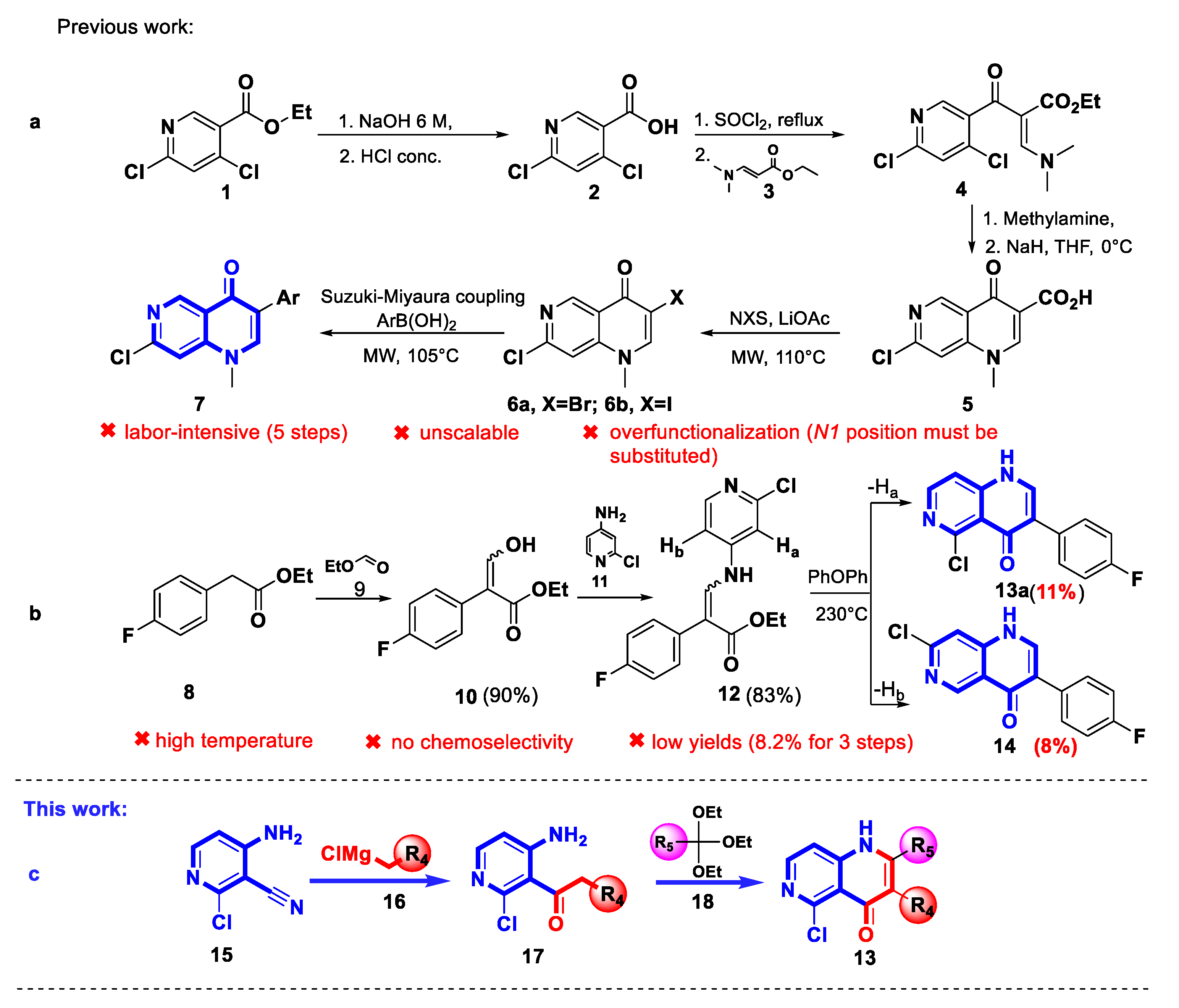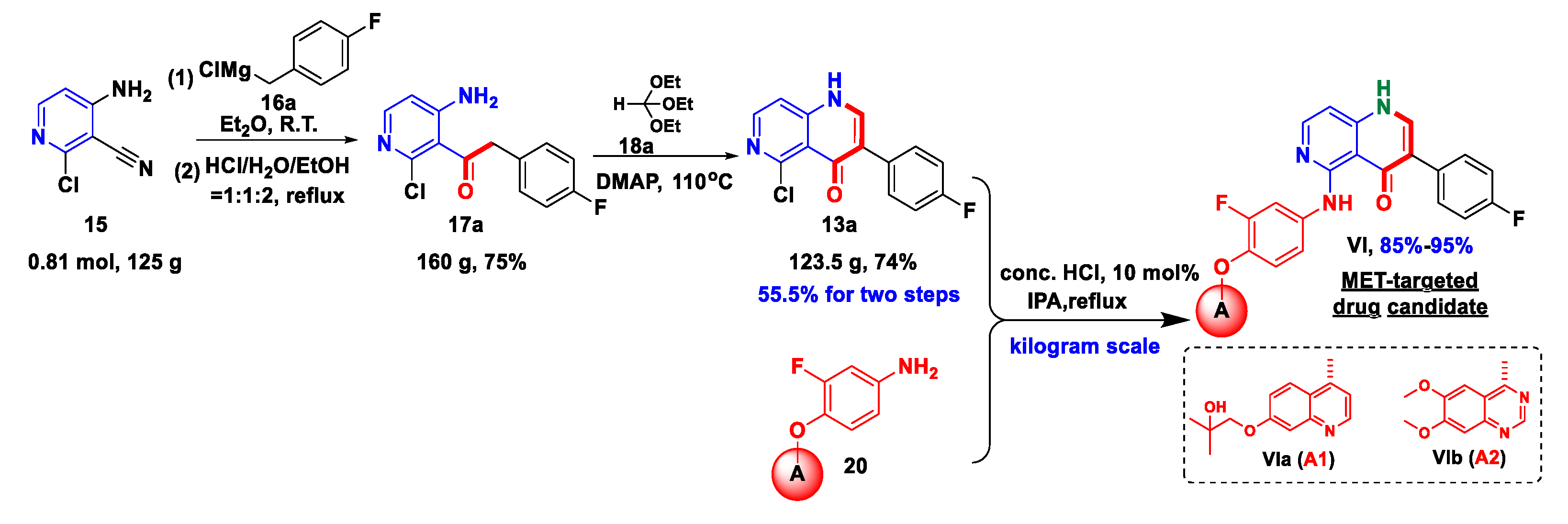Grignard Reagent Utilization Enables a Practical and Scalable Construction of 3-Substituted 5-Chloro-1,6-naphthyridin-4-one Derivatives
Abstract
1. Introduction
2. Results and Discussion
3. Conclusions
4. Materials and Methods
4.1. General Information
4.2. General Procedure I for the Synthesis of 2-Substituted 1-(4-amino-2-chloropyridin-3-yl)-ethan-1-ones 17a–n
4.3. General Procedure II for the Synthesis of 3-Substituted 1,6-naphthyridin-4-ones 13a–o
4.4. Scale-Up Experiment
4.4.1. Mass Preparation of 1-(4-Amino-2-chloropyridin-3-yl)-2-(4-fluorophenyl)ethan-1-one (17a)
4.4.2. Mass Preparation of 5-Chloro-3-(4-fluorophenyl)-1,6-naphthyridin-4-one (13a)
Supplementary Materials
Author Contributions
Funding
Conflicts of Interest
References
- Tabarrini, O.; Massari, S.; Sancineto, L.; Daelemans, D.; Sabatini, S.; Manfroni, G.; Cecchetti, V.; Pannecouque, C. Structural Investigation of the Naphthyridone Scaffold: Identification of a 1,6-Naphthyridone Derivative with Potent and Selective Anti-HIV Activity. ChemMedChem 2011, 6, 1249–1257. [Google Scholar] [CrossRef] [PubMed]
- Madaan, A.; Verma, R.; Kumar, V.; Singh, A.T.; Jain, S.K.; Jaggi, M. 1,8-Naphthyridine Derivatives: A Review of Multiple Biological Activities. Arch. Pharm. 2015, 348, 837–860. [Google Scholar] [CrossRef] [PubMed]
- Martínez-Teipel, B.; Teixidó, J.; Pascual, R.; Mora, M.; Pujolà, J.; Fujimoto, T.; Borrell, J.I.; Michelotti, E.L. 2-Methoxy-6-oxo-1,4,5,6-tetrahydropyridine-3-carbonitriles: Versatile Starting Materials for the Synthesis of Libraries with Diverse Heterocyclic Scaffolds. J. Comb. Chem. 2005, 7, 436–448. [Google Scholar] [CrossRef] [PubMed]
- Zhang, Y.; Sun, R.; Kang, X.; Wang, D.-H.; Chen, Y. A water-soluble 1,8-naphthyridine-based imidazolium molecular gripper for fluorescence sensing and discriminating of GMP. Dye. Pigment. 2020, 174, 108103. [Google Scholar] [CrossRef]
- Ren, R.; Xu, H.-C.; Dong, H.; Peng, H.-T.; Wu, P.-P.; Qiu, Y.; Yang, S.-G.; Sun, Q.; She, N.-F. Ultrafast 2,7-Naphthyridine-Based fluorescent probe for detection of thiophenol with a remarkable Stokes shift and its application In vitro and in vivo. Talanta 2019, 205, 120067. [Google Scholar] [CrossRef]
- Sun, Q.; Ren, R.; Wu, P.-P.; Zhuo, L.-S.; Dong, H.; Peng, H.-T.; Cao, Y.-F.; Luo, X.-G.; She, N.-F. A 2, 7-naphthyridine-based fluorescent turn-on probe for detection of biothiols in vitro and in vivo. Dye. Pigment. 2020, 182, 108702. [Google Scholar] [CrossRef]
- Mu, X.-Y.; Xu, J.; Zhou, Y.-J.; Li, Y.-L.; Liu, Y.; Wang, X.-S. Convenient synthesis of naphtho[1,6] naphthyridine derivatives under catalyst-free conditions. Res. Chem. Intermed. 2013, 41, 1703–1714. [Google Scholar] [CrossRef]
- Singh, I.P.; Kumar, S.; Gupta, S. Naphthyridines with Antiviral Activity-A Review. Med. Chem. 2017, 13, 430–438. [Google Scholar] [CrossRef]
- Peese, K.M.; Allard, C.W.; Connolly, T.; Johnson, B.L.; Li, C.; Patel, M.; Sorensen, M.E.; Walker, M.A.; Meanwell, N.A.; McAuliffe, B.; et al. 5,6,7,8-Tetrahydro-1,6-naphthyridine Derivatives as Potent HIV-1-Integrase-Allosteric-Site Inhibitors. J. Med. Chem. 2019, 62, 1348–1361. [Google Scholar] [CrossRef]
- De Morais Oliveira-Tintino, C.D.; Tintino, S.R.; Muniz, D.F.; dos Santos Barbosa, C.R.; Pereira, R.L.S.; Begnini, I.M.; Rebelo, R.A.; da Silva, L.E.; Mireski, S.L.; Nasato, M.C. Do 1,8-naphthyridine sulfonamides possess an inhibitory action against TetK and MrsA efflux pumps in multiresistant Staphylococcus aureus strains? Microb. Pathog. 2020, 147, 104268. [Google Scholar] [CrossRef]
- Yoo, B.K.; Triller, D.M.; Yong, C.-S.; Lodise, T.P. Gemifloxacin: A New Fluoroquinolone Approved for Treatment of Respiratory Infections. Ann. Pharmacother. 2004, 38, 1226–1235. [Google Scholar] [CrossRef] [PubMed]
- Hong, C.Y.; Kim, Y.K.; Chang, J.H.; Kim, S.H.; Choi, H.; Nam, D.H.; Kim, Y.Z.; Kwak, J.H. Novel Fluoroquinolone Antibacterial Agents Containing Oxime-Substituted (Aminomethyl) pyrrolidines: Synthesis and Antibacterial Activity of 7-(4-(Aminomethyl)-3-(methoxyimino) pyrrolidin-1-yl)-1-cyclopropyl-6-fluoro-4-oxo-1,4-dihydro[1,8] naphthyridine-3-carboxylic Acid (LB20304). J. Med. Chem. 1997, 40, 3584–3593. [Google Scholar]
- Thomas, M.; De Rycker, M.; Wall, R.J.; Spinks, D.; Epemolu, O.; Manthri, S.; Norval, S.; Osuna-Cabello, M.; Patterson, S.; Riley, J. Identification and optimisation of a series of 8-hydroxy naphthyridines with potent in vitro antileishmanial activity: Initial SAR and assessment of in vivo activity. J. Med. Chem. 2020, 63, 9523–9539. [Google Scholar] [CrossRef]
- Meredith, E.L.; Ardayfio, O.; Beattie, K.; Dobler, M.R.; Enyedy, I.; Gaul, C.; Hosagrahara, V.; Jewell, C.; Koch, K.; Lee, W.; et al. Identification of Orally Available Naphthyridine Protein Kinase D Inhibitors. J. Med. Chem. 2010, 53, 5400–5421. [Google Scholar] [CrossRef] [PubMed]
- Fiorito, J.; Vendome, J.; Saeed, F.; Staniszewski, A.; Zhang, H.; Yan, S.; Deng, S.-X.; Arancio, O.; Landry, D.W. Identification of a Novel 1,2,3,4-Tetrahydrobenzo[b][1,6]naphthyridine Analogue as a Potent Phosphodiesterase 5 Inhibitor with Improved Aqueous Solubility for the Treatment of Alzheimer’s Disease. J. Med. Chem. 2017, 60, 8858–8875. [Google Scholar] [CrossRef] [PubMed]
- Srivastava, S.K.; Jha, A.; Agarwal, S.K.; Mukherjee, R.; Burman, A.C. Synthesis and structure-activity relationships of potent antitumor active quinoline and naphthyridine derivatives. Anti Cancer Agents Med. Chem. 2007, 7, 685–709. [Google Scholar] [CrossRef]
- Zhuo, L.-S.; Xu, H.; Wang, M.-S.; Zhao, X.-E.; Ming, Z.-H.; Zhu, X.-L.; Huang, W.; Yang, G. 2,7-naphthyridinone-based MET kinase inhibitors: A promising novel scaffold for antitumor drug development. Eur. J. Med. Chem. 2019, 178, 705–714. [Google Scholar] [CrossRef]
- Wang, M.-S.; Xu, H.; Gong, Y.; Qu, R.-Y.; Zhuo, L.-S.; Huang, W. Efficient Arylation of 2,7-Naphthyridin-1(2H)-one with Diaryliodonium Salts and Discovery of a New Selective MET/AXL Kinase Inhibitor. ACS Comb. Sci. 2020, 22, 9, 457–467. [Google Scholar] [CrossRef]
- Sun, H.; Zhuo, L.; Dong, H.; Huang, W.; She, N.-F. Discovery of 8-Amino-Substituted 2-Phenyl-2,7-Naphthyridinone Derivatives as New c-Kit/VEGFR-2 Kinase Inhibitors. Molecules 2019, 24, 4461. [Google Scholar] [CrossRef]
- Chen, T.; Zhuo, L.-S.; Liu, P.-F.; Fang, W.-R.; Li, Y.; Huang, W. Discovery of 1,6-naphthyridinone-based MET kinase inhibitor bearing quinoline moiety as promising antitumor drug candidate. Eur. J. Med. Chem. 2020, 192, 112174. [Google Scholar] [CrossRef]
- Xu, H.; Wang, M.; Wu, F.; Zhuo, L.; Huang, W.; She, N.-F. Discovery of N-substituted-3-phenyl-1,6-naphthyridinone derivatives bearing quinoline moiety as selective type II c-Met kinase inhibitors against VEGFR-2. Bioorganic Med. Chem. 2020, 28, 115555. [Google Scholar] [CrossRef] [PubMed]
- Wang, M.-S.; Zhuo, L.-S.; Yang, F.-P.; Wang, W.-J.; Huang, W.; Yang, G.-F. Synthesis and biological evaluation of new MET inhibitors with 1,6-naphthyridinone scaffold. Eur. J. Med. Chem. 2019, 185, 111803. [Google Scholar] [CrossRef] [PubMed]
- Wu, F.; Zhuo, L.; Wang, F.; Huang, W.; Hao, G.; Yang, G.-F. Auto in Silico Ligand Directing Evolution to Facilitate the Rapid and Efficient Discovery of Drug Lead. iScience 2020, 23, 101179. [Google Scholar] [CrossRef]
- Gopalsamy, A.; Shi, M.; Boschelli, D.H.; Williamson, R.; Olland, A.; Hu, Y.; Krishnamurthy, G.; Han, X.; Arndt, A.K.; Guo, B. Discovery of Dibenzo[c,f][2,7]naphthyridines as Potent and Selective 3-Phosphoinositide-Dependent Kinase-1 Inhibitors. J. Med. Chem. 2007, 50, 5547–5549. [Google Scholar] [CrossRef] [PubMed]
- Litvinov, V. Advances in the Chemistry of Naphthyridines. Adv. Heterocycl. Chem. 2006, 91, 189–300. [Google Scholar] [CrossRef]
- Suzuki, H.; Sakai, N.; Iwahara, R.; Fujiwaka, T.; Satoh, M.; Kakehi, A.; Konakahara, T. Novel Synthesis of 7-Fluoro-8-(trifluoromethyl)- 1H-1,6-naphthyridin-4-one Derivatives: Intermolecular Cyclization of anN-Silyl-1-azaallyl Anion with Perfluoroalkene and Subsequent Intramolecular Skeletal Transformation of the Resulting Pentasubstituted Pyridines. J. Org. Chem. 2007, 72, 5878–5881. [Google Scholar] [CrossRef]
- Morgentin, R.; Pasquet, G.; Boutron, P.; Jung, F.; Lamorlette, M.; Maudet, M.; Ple, P. Strategic studies in the syntheses of novel 6,7-substituted quinolones and 7- or 6-substituted 1,6- and 1,7-naphthyridones. Tetrahedron 2008, 64, 2772–2782. [Google Scholar] [CrossRef]
- Zeng, L.-F.; Wang, Y.; Kazemi, R.; Xu, S.; Xu, Z.-L.; Sanchez, T.W.; Yang, L.-M.; Debnath, B.; Odde, S.; Xie, H.; et al. Repositioning HIV-1 Integrase Inhibitors for Cancer Therapeutics: 1,6-Naphthyridine-7-carboxamide as a Promising Scaffold with Drug-like Properties. J. Med. Chem. 2012, 55, 9492–9509. [Google Scholar] [CrossRef]
- Falardeau, G.; Lachance, H.; St-Pierre, A.; Yannopoulos, C.G.; Drouin, M.; Bédard, J.; Chan, L. Design and synthesis of a potent macrocyclic 1,6-napthyridine anti-human cytomegalovirus (HCMV) inhibitors. Bioorganic Med. Chem. Lett. 2005, 15, 1693–1695. [Google Scholar] [CrossRef]
- Wang, Y.; Bullock, W.H.; Chen, L. 1,6-naphthyridine Derivatives as Antidiabetics. WO 03027113A1, 3 April 2003. [Google Scholar]
- Sanchez, J.P.; Gogliotti, R.D. The synthesis of a series of 7-amino-1-cyclopropyl-8-fluoro-1,4-dihydro-4-oxo-1,6-naphthyridine-3-carboxylic acids as potential antibacterial agents. J. Heterocycl. Chem. 1993, 30, 855–859. [Google Scholar] [CrossRef]
- Gündisch, D.; Eibl, C. Nicotinic acetylcholine receptor ligands, a patent review (2006–2011). Expert Opin. Ther. Patents 2011, 21, 1867–1896. [Google Scholar] [CrossRef] [PubMed]
- Richard, K. Alpha7 Nicotinic Acetylcholine Receptor Allosteric Modulators, Their Derivatives and Uses Thereof. WO 2010083444A1, 15 January 2009. [Google Scholar]
- Dembélé, O.; Montoir, D.; Yvorra, T.; Sérillon, D.; Tonnerre, A.; Duflos, M.; Robert, J.-M.; Bazin, M.-A. Novel approach towards 3,7-disubstituted 1,6-naphthyridin-4(1H)-ones exploiting cross-coupling and SNAr reactions of a dihalogenated compound. Tetrahedron Lett. 2018, 59, 3519–3523. [Google Scholar] [CrossRef]
- Kumpiņa, I.; Isaksson, R.; Sävmarker, J.; Wannberg, J.; Larhed, M. Microwave Promoted Transcarbamylation Reaction of Sulfonylcarbamates under Continuous-Flow Conditions. Org. Process. Res. Dev. 2016, 20, 440–445. [Google Scholar] [CrossRef]
- Tabarrini, O.; Stevens, M.; Cecchetti, V.; Sabatini, S.; Dell’Uomo, M.; Manfroni, G.; Palumbo, M.; Pannecouque, C.; De Clercq, E.; Fravolini, A. Structure Modifications of 6-Aminoquinolones with Potent Anti-HIV Activity1. J. Med. Chem. 2004, 47, 5567–5578. [Google Scholar] [CrossRef] [PubMed]










| Entry | 2–5 Equiv. | Solvent | Temp. (°C) | Reaction Time (h) | Yield c (%) |
|---|---|---|---|---|---|
| 1 | 2 | THF | 25 | 16 | 5 |
| 2 | 2 | Et2O | 25 | 16 | 20 |
| 3 | 2 | Et2O | 30 | 12 | 35 |
| 4 | 2 | Methyl tert-butyl ether | 30 | 12 | 10 |
| 5 | 2 | Isopropyl ether | 30 | 12 | 7 |
| 6 | 2 | Toluene | 30 | 12 | Trace |
| 7 | 3 | Et2O | 30 | 12 | 60 |
| 8 | 4 | Et2O | 30 | 12 | 74 |
| 9 | 5 | Et2O | 30 | 12 | 73 |
| Entry | Base (equiv.) | Solvent | Temp. (°C) | Reaction Time (h) | Yield b (%) |
|---|---|---|---|---|---|
| 1 | K2CO3 (2eq) | DMF | 110 | 24 | <1 |
| 2 | NaH (2eq) | THF | 60 | 24 | <1 |
| 3 | Et3N (2eq) | DMF | 110 | 24 | 15 |
| 4 | DIPEA (2eq) | DMF | 110 | 24 | 30 |
| 5 | DMAP (2eq) | DMF | 110 | 24 | 65 |
| 6 | DMAP (2eq) | HC(OEt)3 | 110 | 24 | 70 |
| 7 | DMAP (1eq) | HC(OEt)3 | 110 | 24 | 70 |
| 8 | DMAP (0.1 eq) | HC(OEt)3 | 110 | 24 | 72 |
| 9 | No catalyst | HC(OEt)3 | 110 | 24 | 0 |
Sample Availability: Not available. | |
Publisher’s Note: MDPI stays neutral with regard to jurisdictional claims in published maps and institutional affiliations. |
© 2020 by the authors. Licensee MDPI, Basel, Switzerland. This article is an open access article distributed under the terms and conditions of the Creative Commons Attribution (CC BY) license (http://creativecommons.org/licenses/by/4.0/).
Share and Cite
Wang, M.-S.; Gong, Y.; Yu, Z.-C.; Tian, Y.-G.; Zhuo, L.-S.; Huang, W.; She, N.-F. Grignard Reagent Utilization Enables a Practical and Scalable Construction of 3-Substituted 5-Chloro-1,6-naphthyridin-4-one Derivatives. Molecules 2020, 25, 5667. https://doi.org/10.3390/molecules25235667
Wang M-S, Gong Y, Yu Z-C, Tian Y-G, Zhuo L-S, Huang W, She N-F. Grignard Reagent Utilization Enables a Practical and Scalable Construction of 3-Substituted 5-Chloro-1,6-naphthyridin-4-one Derivatives. Molecules. 2020; 25(23):5667. https://doi.org/10.3390/molecules25235667
Chicago/Turabian StyleWang, Ming-Shu, Yi Gong, Zhi-Cheng Yu, Yan-Guang Tian, Lin-Sheng Zhuo, Wei Huang, and Neng-Fang She. 2020. "Grignard Reagent Utilization Enables a Practical and Scalable Construction of 3-Substituted 5-Chloro-1,6-naphthyridin-4-one Derivatives" Molecules 25, no. 23: 5667. https://doi.org/10.3390/molecules25235667
APA StyleWang, M.-S., Gong, Y., Yu, Z.-C., Tian, Y.-G., Zhuo, L.-S., Huang, W., & She, N.-F. (2020). Grignard Reagent Utilization Enables a Practical and Scalable Construction of 3-Substituted 5-Chloro-1,6-naphthyridin-4-one Derivatives. Molecules, 25(23), 5667. https://doi.org/10.3390/molecules25235667






